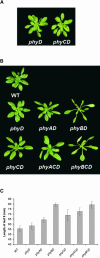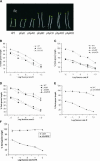Mutant analyses define multiple roles for phytochrome C in Arabidopsis photomorphogenesis
- PMID: 12953105
- PMCID: PMC181325
- DOI: 10.1105/tpc.015164
Mutant analyses define multiple roles for phytochrome C in Arabidopsis photomorphogenesis
Abstract
The analysis of Arabidopsis mutants deficient in the A, B, D, and E phytochromes has revealed that each of these phytochrome isoforms has both distinct and overlapping roles throughout plant photomorphogenesis. Although overexpression studies of phytochrome C (phyC) have suggested photomorphogenic roles for this receptor, conclusive evidence of function has been lacking as a result of the absence of mutants in the PHYC locus. Here, we describe the isolation of a T-DNA insertion mutant of phyC (phyC-1), the subsequent creation of mutant lines deficient in multiple phytochrome combinations, and the physiological characterization of these lines. In addition to operating as a weak red light sensor, phyC may perform a significant role in the modulation of other photoreceptors. phyA and phyC appear to act redundantly to modulate the phyB-mediated inhibition of hypocotyl elongation in red light and to function together to regulate rosette leaf morphology. In addition, phyC performs a significant role in the modulation of blue light sensing. Several of these phenotypes are supported by the parallel analysis of a quadruple mutant deficient in phytochromes A, B, D, and E, which thus contains only active phyC. Together, these data suggest that phyC has multiple functions throughout plant development that may include working as a coactivator with other phytochromes and the cryptochrome blue light receptors.
Figures






Similar articles
-
Isolation and characterization of phyC mutants in Arabidopsis reveals complex crosstalk between phytochrome signaling pathways.Plant Cell. 2003 Sep;15(9):1962-80. doi: 10.1105/tpc.012971. Plant Cell. 2003. PMID: 12953104 Free PMC article.
-
Conditional synergism between cryptochrome 1 and phytochrome B is shown by the analysis of phyA, phyB, and hy4 simple, double, and triple mutants in Arabidopsis.Plant Physiol. 1998 Sep;118(1):19-25. doi: 10.1104/pp.118.1.19. Plant Physiol. 1998. PMID: 9733522 Free PMC article.
-
shl, a New set of Arabidopsis mutants with exaggerated developmental responses to available red, far-red, and blue light.Plant Physiol. 2001 Sep;127(1):295-304. doi: 10.1104/pp.127.1.295. Plant Physiol. 2001. PMID: 11553757 Free PMC article.
-
Photomophogenesis: Phytochrome takes a partner!Curr Biol. 1999 Mar 25;9(6):R225-7. doi: 10.1016/s0960-9822(99)80135-3. Curr Biol. 1999. PMID: 10209091 Review.
-
Photoreceptors in plant photomorphogenesis to date. Five phytochromes, two cryptochromes, one phototropin, and one superchrome.Plant Physiol. 2001 Jan;125(1):85-8. doi: 10.1104/pp.125.1.85. Plant Physiol. 2001. PMID: 11154303 Free PMC article. Review. No abstract available.
Cited by
-
Arabidopsis thaliana life without phytochromes.Proc Natl Acad Sci U S A. 2010 Mar 9;107(10):4776-81. doi: 10.1073/pnas.0910446107. Epub 2010 Feb 22. Proc Natl Acad Sci U S A. 2010. PMID: 20176939 Free PMC article.
-
Phytochromes are the sole photoreceptors for perceiving red/far-red light in rice.Proc Natl Acad Sci U S A. 2009 Aug 25;106(34):14705-10. doi: 10.1073/pnas.0907378106. Epub 2009 Aug 12. Proc Natl Acad Sci U S A. 2009. PMID: 19706555 Free PMC article.
-
Tissue- and isoform-specific phytochrome regulation of light-dependent anthocyanin accumulation in Arabidopsis thaliana.Plant Signal Behav. 2011 May;6(5):624-31. doi: 10.4161/psb.6.5.15084. Epub 2011 May 1. Plant Signal Behav. 2011. PMID: 21455024 Free PMC article.
-
Phytochrome A and B Regulate Primary Metabolism in Arabidopsis Leaves in Response to Light.Front Plant Sci. 2017 Aug 9;8:1394. doi: 10.3389/fpls.2017.01394. eCollection 2017. Front Plant Sci. 2017. PMID: 28848593 Free PMC article.
-
Bottom-up Assembly of the Phytochrome Network.PLoS Genet. 2016 Nov 7;12(11):e1006413. doi: 10.1371/journal.pgen.1006413. eCollection 2016 Nov. PLoS Genet. 2016. PMID: 27820825 Free PMC article.
References
-
- Ahmad, M., and Cashmore, A.R. (1997). The blue light receptor cryptochrome 1 shows functional dependence on phytochrome A or phytochrome B in Arabidopsis thaliana. Plant J. 11, 421–427. - PubMed
-
- Bradley, J.M., Murphy, G.P., Whitelam, G.C., and Harberd, N.P. (1996). Identification of phytochrome B amino acid residues mutated in three new phyB mutants of Arabidopsis thaliana. J. Exp. Bot. 47, 1449–1455.
-
- Briggs, W.R., and Huala, E. (1999). Blue-light photoreceptors in higher plants. Annu. Rev. Cell Dev. Biol. 15, 33–62. - PubMed
Publication types
MeSH terms
Substances
LinkOut - more resources
Full Text Sources
Other Literature Sources
Molecular Biology Databases

